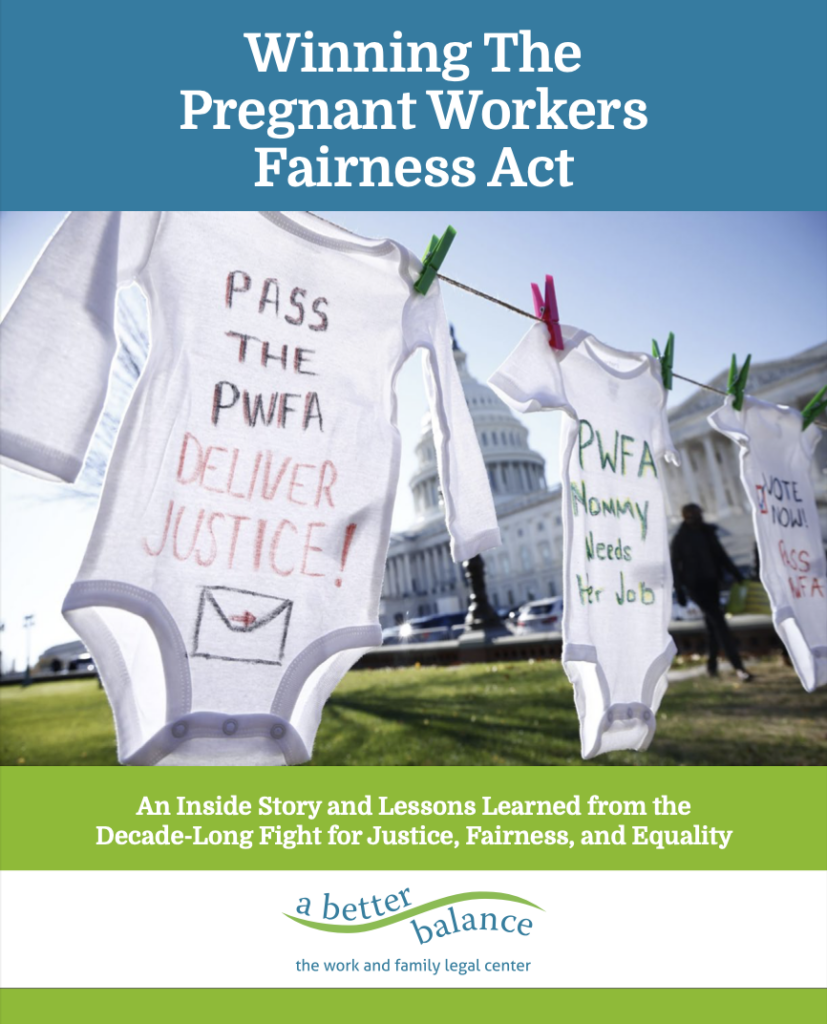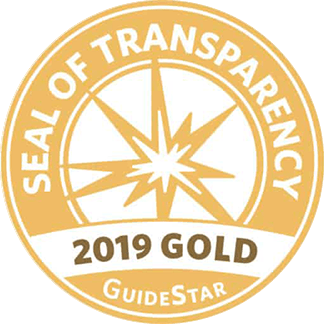An Inside Story and Lessons Learned from the Decade-Long Fight for Justice, Fairness, and Equality
Winning the Pregnant Workers Fairness Act documents the history of the decade-long movement to pass the Pregnant Workers Fairness Act (PWFA). The PWFA passed in December 2022, after a ten-year campaign to ensure pregnant workers are afforded fairness, dignity, and equality under the law.
The new law closes a pernicious gap in our nation’s civil rights laws that forced countless pregnant workers to choose between a paycheck and a healthy pregnancy. The PWFA affords millions of pregnant and postpartum workers, particularly Black and Latina women in low-wage, inflexible, and male-dominated jobs, crucial new protections during pregnancy and immediately after childbirth to protect their health and keep their jobs. The law provides pregnant and postpartum workers an explicit right to reasonable accommodations, absent undue hardship to their employers.
Since the PWFA’s passage, many people have asked us: How did a major piece of civil rights legislation pass in a heavily partisan and divided Congress? The answer is multifaceted and complex. Winning the Pregnant Workers Fairness Act tells the detailed 10-year history of the PWFA movement and provides insight into the key tactics and strategies we believe were most fruitful in passing the legislation.
We hope Winning the Pregnant Workers Fairness Act also serves as a roadmap for future advocacy campaigns. The full report—including a detailed timeline of events and appendix listing hundreds of supporting organizations from throughout the years—is available for download here. Below is a synopsis.
Additional materials:
Press Release | June 27, 2023: “As Pregnant Workers Fairness Act Becomes Law Today, Millions of Pregnant and Postpartum Workers Have Gained Crucial Protections for Health & Economic Security“
Press release | December 23, 2022: “A Better Balance Celebrates Pregnant Workers Fairness Act & PUMP Act Inclusion in Omnibus As A Momentous Victory for Moms, Moms-To-Be, Working Families”
Video: “Winning the Pregnant Workers Fairness Act: The Decade-Long Movement for Justice & Equity“
We utilized 8 key tactics and strategies to make this victory a reality:
1. Center Workers. They Are Experts and Leaders.
2. Make Progress in States.
3. Build a Broad Coalition & Engage Diverse Stakeholders.
4. Gain Business Support.
5. Achieve Robust Bipartisan Support.
6. Build Relationships with Lawmakers & Regularly Create New Educational Materials to Maintain the Urgency of the Issue.
7. Channel the Power of Communications & Use Consistent, Values-Based Messaging.
Read more on these lessons learned and the road to passing the Pregnant Workers Fairness Act below and in Winning The Pregnant Workers Fairness Act.
CHAPTER 1: How We Identified That Pregnant Workers, Especially Women in Low-Wage and Physically Demanding Jobs, Were Falling Through the Cracks Of Federal Civil Rights Laws
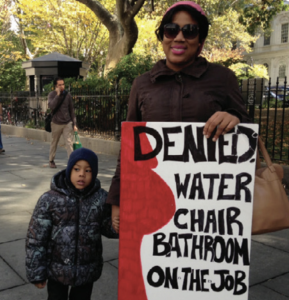
There are many ways to tell the story of how Congress passed the Pregnant Workers Fairness Act (PWFA). It is a story about workers—overwhelmingly women in low-wage and male-dominated jobs—who did not shy away from bravely and boldly sharing their stories, alongside unrelenting advocates who demanded Congress afford them long overdue protection. It is the story of unlikely allies, federally and around the country, forging deep partnerships—another rarity, especially in the realm of labor and workplace rights. It is about the triumph of bipartisanship, a rarer and rarer occurrence in today’s highly polarized political climate. And it is the story of legal experts sounding the alarm bells, and refusing to accept, the severe limitations of the law, especially when it comes to serving the most vulnerable and marginalized.
In 2011, A Better Balance Co-Founder & Co-President Dina Bakst recognized a disturbing pattern when speaking with workers and reviewing case law: pregnant workers, especially women in low-wage and physically demanding jobs, were facing terrible mistreatment at work- and current law offered little help. It was clear they needed immediate relief to protect their health and stay attached to the workforce.
Getting fired or forced off the job while pregnant can lead to losing critical income and health benefits, food insecurity, and homelessness.
CHAPTER 2: How the PWFA Was Born: Spotlighting the Problem and Offering a Solution
In January 2012, Bakst penned an Op-Ed in The New York Times that highlighted the continued injustice pregnant and postpartum workers face:
“No pregnant woman in this country should have to choose between her job and a healthy pregnancy.” – A Better Balance Co-Founder and Co-President Dina Bakst, 2012
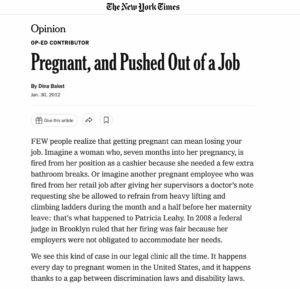
From there, she offered a solution. Legislators, she wrote, could pass laws providing pregnant workers an affirmative right to reasonable accommodations, absent undue hardship to employers. Pregnancy accommodations are good for public health, family economic security, and an employer’s bottom line.
The Op-Ed ignited a firestorm, exposing the horrifying reality facing pregnant workers. As Bakst recalls from that time:
“For so many, the Op-Ed was the first time they learned about this gap in our federal laws and the continued prevalence of this form of pregnancy discrimination, despite laws on the books meant to help…The day my Op-Ed was published, Representative Jerrold Nadler (D-NY) reached out to me saying he had read the piece and wanted to work together to draft federal legislation.”
CHAPTER 3: Our Solution to the Problem: The PWFA
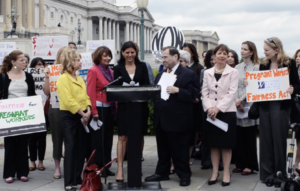
Lawmakers heeded A Better Balance’s call for new legislation, readily grasping the importance of passing a law that would specifically address the fundamental gaps in protections for pregnant and postpartum workers.
In February 2012, Representative Nadler (D-NY) publicly announced that he was working on legislation to address the problem identified in Bakst’s New York Times Op-Ed. That spring, he invited A Better Balance and leading women’s rights and economic justice groups to discuss how to best craft the bill language for the Pregnant Workers Fairness Act .
Ultimately, the working group decided that a stand-alone bill—in many ways mirroring the Americans with Disabilities Act (ADA) but also taking into consideration the ways pregnancy may differ as a temporary medical condition—would be the cleanest approach.
On May 8, 2012, Representatives Nadler, along with Representative Maloney (D-NY) and other colleagues, introduced the Pregnant Workers Fairness Act in the House of Representatives. A few months later, on September 19, 2012, U.S. Senator Bob Casey (D-PA) introduced the same bill in the Senate.The Pregnant Workers Fairness Act guarantees pregnant and postpartum workers the right to reasonable accommodation for known limitations related to pregnancy, childbirth, or related medical conditions, unless such accommodations would pose an undue hardship to the employer. The report lays out the nuts and bolts of the PWFA in further detail.
Failure to access pregnancy accommodations in the workplace can lead to complications such as preterm birth, preeclampsia, and miscarriage.
CHAPTER 4: Making the Legal, Economic, and Health Cases
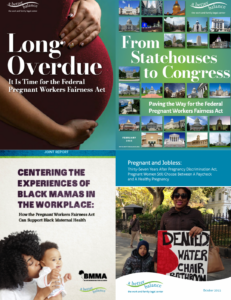
Even while drafting the Pregnant Workers Fairness Act in 2012, advocates and lawmakers both knew that this new bill was unlikely to pass in a divided Congress. Advocacy groups thus focused on educating members of Congress, stakeholders, and the public about the problem and solution at hand while also turning to cities and states to make progress and help make the case federally.
Making the legal case: We had long argued that the Pregnancy Discrimination Act (PDA) and the Americans with Disabilities Act Amendments Act (ADAAA) provided inadequate legal protections for pregnant workers. Then, in an extensive 2019 report, Long Overdue, A Better Balance published original legal research, which Co-Founder Dina Bakst shared at a 2019 and 2021 Congressional hearing, showing that in over two-thirds of cases, courts held that employers were permitted to deny pregnant workers accommodations under the PDA.
Making the economic case: To make the case for the PWFA from an economic justice perspective, we shared both quantitative data and anecdotal evidence of the lost income, job opportunities, benefits, seniority, housing and food security, and other severe economic consequences pregnant workers suffered when denied accommodations. Winning the Pregnant Workers Fairness Act further details the many ways that combatting pregnancy discrimination has significant implications for our country’s economy as well.
Making the health case: We highlighted the broader maternal and infant health benefits of workplace accommodations and worked with partners to emphasize the importance of the PWFA as one way to help address the Black maternal health crisis. We heard from health care providers who treated patients for dehydration after fainting on the job because they weren’t allowed to drink water or suffered miscarriages after being forced to continue to lift heavy boxes. These points, combined with the urgency of the pandemic and its negative health effects on pregnancy, presented compelling arguments to federal lawmakers on the necessity of passing the Pregnant Workers Fairness Act without delay.
Two-thirds of women lost their pregnancy accommodation cases in federal court before the Pregnant Workers Fairness Act.
CHAPTER 5: Tactics and Strategies: How We Passed the PWFA
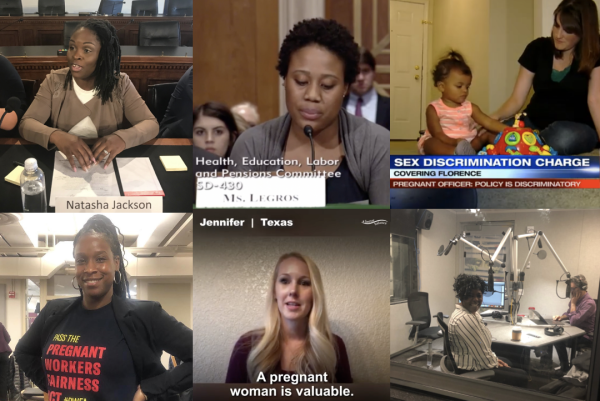
Passing the Pregnant Workers Fairness Act took over a decade of savvy advocacy, sustained pressure, and daily, often unglamorous, behind-the-scenes work to raise the profile of the issue and navigate the thorny politics of Washington, D.C.
This prolonged work afforded us a larger perspective on the strategies that proved to be most impactful and effective in getting the bill passed into law. Chapter 5 of Winning the Pregnant Workers Fairness Act describes in-depth the eight tactics and strategies we believe were most fruitful to the PWFA campaign and may be able to serve as a roadmap for future advocacy campaigns:
No one made the case for the Pregnant Workers Fairness Act better than the expecting and new moms who personally faced the adversity of working for employers that refused to provide them modest accommodations and forced them into devastating binds. In 2014, ABB Community Advocate Armanda Legros testified before the Senate Health, Education, Labor, and Pensions Committee. She told Senators:
“Once my baby arrived, just putting food on the table for him and my four-year-old was a challenge. I was forced to use water in his cereal at times because I could not afford milk.”
– Armanda Legros testifying before Congress, 2014
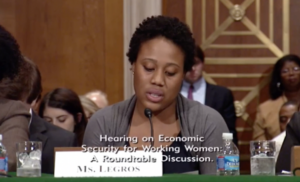
Our goal was to provide workers who wished to speak out a platform to share their lived expertise with those in power, in their own words, be that through reports, testimony, meetings with lawmakers, Op-Eds, or social media. The PWFA exists today because they sacrificed time and anonymity to show up in our nation’s halls of power and in the pages of leading newspapers to demand that no other worker should have to choose between having a family and putting food on the table. Our Congressional champions carried these women’s stories throughout the halls of Congress, moved by their lived expertise and determined to fight for them.
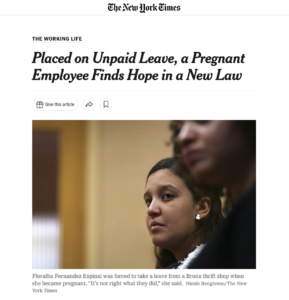
While we worked to pass the federal PWFA, we also turned our attention to working with partners to codify similar protections in states. From 2012 when Bakst published her Op-Ed in The New York Times to 2022 when the federal PWFA passed, twenty-six state pregnant workers fairness bills became law. This effort to pass state pregnant workers fairness laws served two critical purposes. First, pregnant workers needed a right to accommodations now. We knew that state bills could move more quickly than the federal legislation. Second, state-level momentum played a critical role in advancing the federal legislation, especially as we made progress in red states in the South.
Congressional leaders learned about workers in states and cities with existing protections who immediately benefited from these critical protections, like A Better Balance former client Floralba Espinal, who used the New York City Pregnant Workers Fairness Act to return to her job quickly and with the accommodations she needed for her health. Additionally, bipartisan support at the state-level led to bipartisan federal support as well.
We did none of this work alone. Working in coalition, especially with on-the-ground partners, was critical to success in the states. And, in turn, state partners—from both states where laws passed and states where campaigns stalled—activated to support the federal work. Regardless of whether they succeeded in winning protections for workers in their own state, they were deeply committed to passing a law that would protect pregnant people across the country.
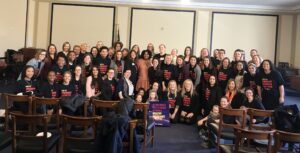
By the time the PWFA passed in December 2022, hundreds of workers’ rights, civil rights, gender justice, racial justice, labor, health, disability, and faith organizations, as well as companies and business associations, actively supported the legislation and engaged in the effort to pass the PWFA. Each of these organizations—both national and state-based—brought a unique perspective to the issue and, together, built a diverse and far-reaching case for why Congress needed to provide a right to accommodationsfor pregnant and postpartum workers. Winning the PWFA goes into great detail about how different stakeholders and constituencies played critical roles—engaging in both grasstops and grassroots ways—in uplifting the myriad reasons Congress needed to prioritize passing PWFA.
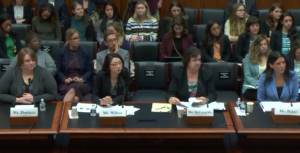
A crucial turning point in accomplishing widespread bipartisanship came from our fruitful negotiations with the U.S. Chamber of Commerce, leading to their vigorous support for the PWFA. We deployed lessons learned from our negotiations with business stakeholders in the states and intense legal research to craft a stronger bill that addressed business groups’ concerns without sacrificing our values.
Many business groups initially opposed the bill, fearing it would prove burdensome. Sustained work over many years, first at the state level and then at the federal level, turned the tide. We made a concerted effort to engage local and state business groups, and later national business groups, about why the PWFA stood to benefit them as well. In those conversations, we sat across from business leaders and explained how the PWFA would:
- create clarity for businesses about their obligations;
- help them retain valuable employees, boosting employee morale and ensuring smooth business operations; and
- reduce their litigation exposure and health care costs
Most importantly, the changes we made to the bill as a result of the negotiations in no way compromised the substance or protections for workers in the bill. Indeed, the modest changes provided helpful clarity to the bill and ultimately provided greater protections to workers.
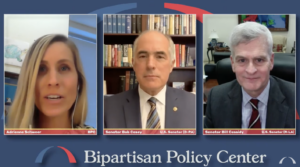
We knew from the beginning that given the makeup of Congress over the last ten years we would need bipartisan support to pass the PWFA. We also knew that bipartisanship came with risks, and we committed to not watering down the bill or making compromises that would weaken protections for workers. We built bipartisanship in three key ways:
First, we shared with lawmakers the experiences of pregnant workers and constituents from their own districts, helping them understand that real people in their communities were suffering without the PWFA. Second, we garnered the business community’s support to show that workers’ and employers’ interests aligned on the PWFA. Third, we explained that the PWFA would save taxpayer dollars by keeping pregnant workers healthy and attached to the workforce.
Once in support, the business community joined us in engaging members from both parties to successfully garner bipartisanship, despite ever-growing political polarization and toxicity between the two parties. The PWFA proved that targeted messaging and effective communication of workers’ lived experiences could transcend political polarization.
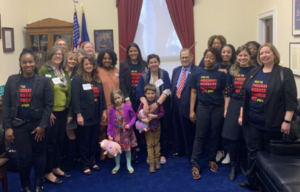
For ten years, we knew the law had a problem that needed fixing. Sustained relationship-building was required to keep lawmakers informed, educated, and attuned to the urgency of the issue. Day in and day out, we worked most closely with our lead sponsors from both sides of the aisle, Representatives Jerry Nadler (D-NY and John Katko (R-NY) in the House of Representatives and Senators Bob Casey (D-PA) and Bill Cassidy (R-LA) in the Senate, as well as with the staff of the Senate Health, Education, Labor, and Pensions (“HELP”) Committee and House Education and Labor Committee. Speaker of the House Nancy Pelosiand the House Democratic Women’s Caucus were also critical champions.
Speaker Pelosi twice ushered the PWFA to overwhelming passage in the House and fought for the bill’s success until the very end of the 117th Congress. Building and sustaining relationships with lawmakers is critical to ensuring that the issue remains high on the priority list and that they have the support and resources they need to advance the legislation.

Consistent messaging and a robust communications strategy were key pieces of the successful PWFA campaign. Early on, we recognized that we would need powerful messages and storytelling that would resonate with a variety of audiences: conservative, progressive, apolitical, grassroots, and across geographic lines. Communications tactics included earned and paid media, including opinion pieces, as well as plentiful social media activities and videos. Although the nuances shifted over time or varied depending on the audience, our core messages stayed remarkably consistent over the past decade. Lawmakers, stakeholders, and constituents were persuaded by the arguments that the PWFA:
» would ensure fairness and equality by supporting women and families’ health and economic security;
» was necessary to close gaps in current law; and
» was a commonsense measure with broad appeal.
The values-based message we repeated most often: no one should have to choose between a healthy pregnancy and paycheck.
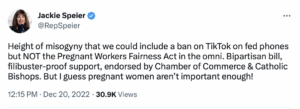
In May 2021, the PWFA passed the House of Representatives for a second time. In August 2021, the PWFA passed with overwhelming support out of the Senate HELP Committee. However, the PWFA coalition had to engage in almost a year and a half of sustained advocacy to push as hard as possible for passage in the Senate. Over that year, we called for passage of the PWFA by holding rallies, authoring op-eds, circulating numerous sign-on letters, strategically placing ads in newspapers, including placing a full page ad in The New York Times from 125 working mothers, and engaging heavily on social media.
In late 2022, after facing multiple setbacks in bringing the bill to a floor vote and with just two weeks left of the Congressional session, the only option that remained was to try and include the PWFA in the year-end omnibus fiscal spending bill before the end of the Congressional session. If it didn’t pass in 2022, we knew it had little chance of passage in the new Congress. Our Senate champions, Senators Cassidy and Casey, proved heroic in their unwavering commitment to get the PWFA passed, and Senator Schumer’s strong support at this juncture was essential. The last-ditch effort to pass the PWFA —following days of nail biting and uncertainty—worked. On December 22, 2022, the PWFA passed in the Senate, as an amendment to the omnibus. The next day, thanks to Speaker Pelosi and Congressman Nadler’s leadership, the PWFA passed the House of Representatives as part of the omnibus. The following week, on December 29, 2022, President Biden signed the PWFA into law when he signed the omnibus spending package into law.
The key lesson learned? Never, ever give up.
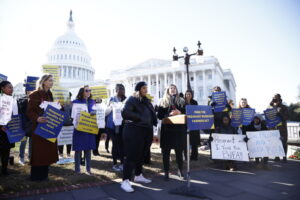
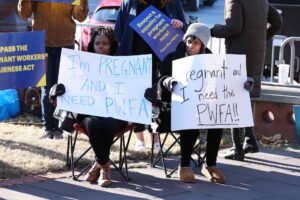
Twenty-six states passed pregnant worker fairness laws between 2013 and 2023.
CHAPTER 6: How States Paved the Way for the Federal PWFA
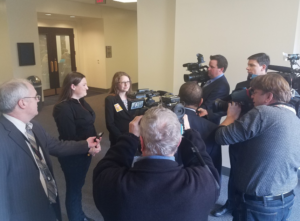
Without a doubt, the PWFA is now a federal law thanks to the parallel movement over the past decade to pass similar legislation at the state and local level. In the states, we worked in coalitions and learned to hone key arguments and garner support from a diverse set of lawmakers and stakeholders—messaging and allies that proved crucial in the federal effort. The concerted state and local PWFA movement—where twenty-six states passed laws in less than ten years—began in 2013, when New York City became the first jurisdiction to enact a comprehensive and robust local PWFA as part of the new wave of laws since California’s law passed in 1999.
This state-by-state work was incredibly time-consuming and often took years of deep coalition work, state-specific legal research, tailored legal bill and amendment drafting, strategizing, and overcoming opposition. Making progress in the states, especially in very conservative states in the South, showed federal lawmakers the universal appeal of the bill and that bipartisanship on the issue was possible.
CHAPTER 7: Next Steps: The Need Going Forward
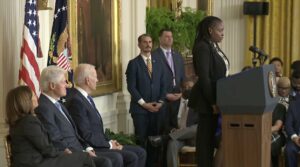
As proud as A Better Balance is of leading the effort to pass the federal PWFA, our work and partnerships are only just beginning. Laws are only meaningful if workers know their rights and can enforce them. This is particularly true for low-wage workers who so often have little access to legal information and cannot afford legal representation. Our next challenge is to work with a vast array of agency partners, organizations, and individuals to ensure that the PWFA transforms the lives of millions of workers and families across the country.
The passage of the PWFA proves that policy victories are possible with the hard work of dedicated legislative champions, and hundreds of organizations and individuals who never gave up.

